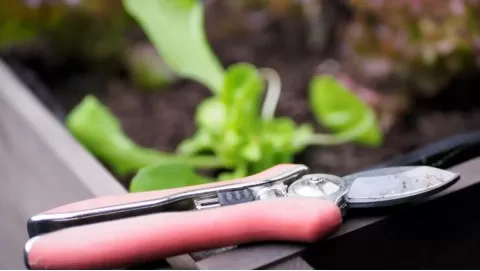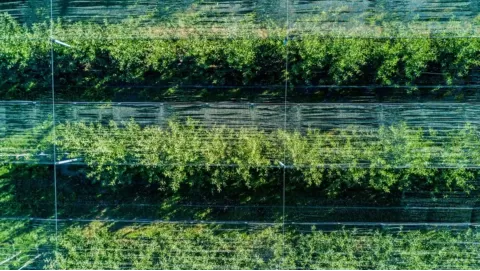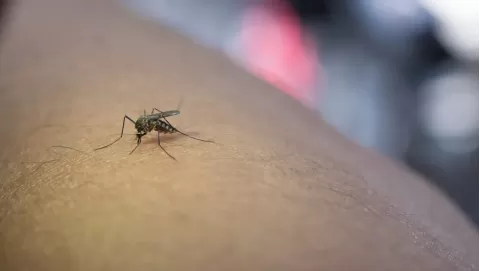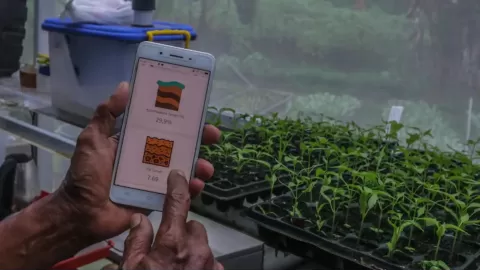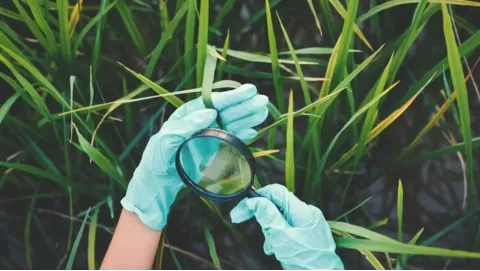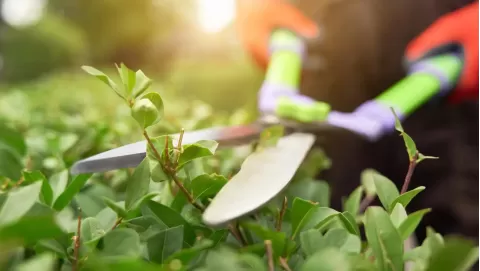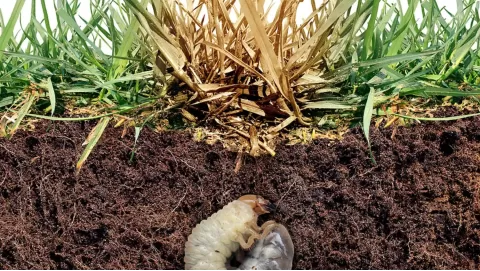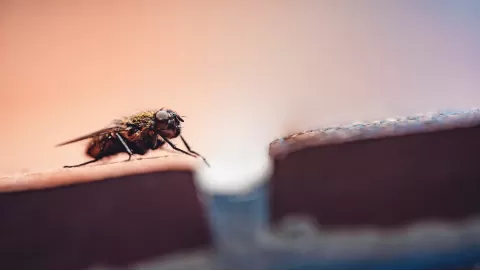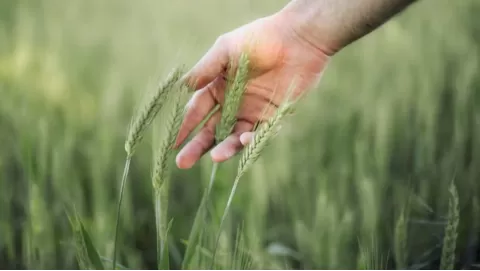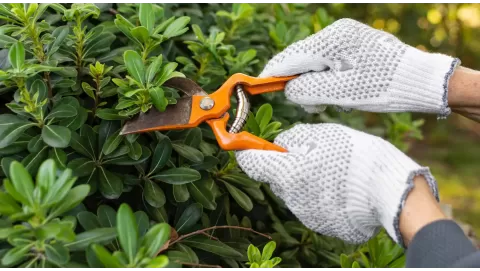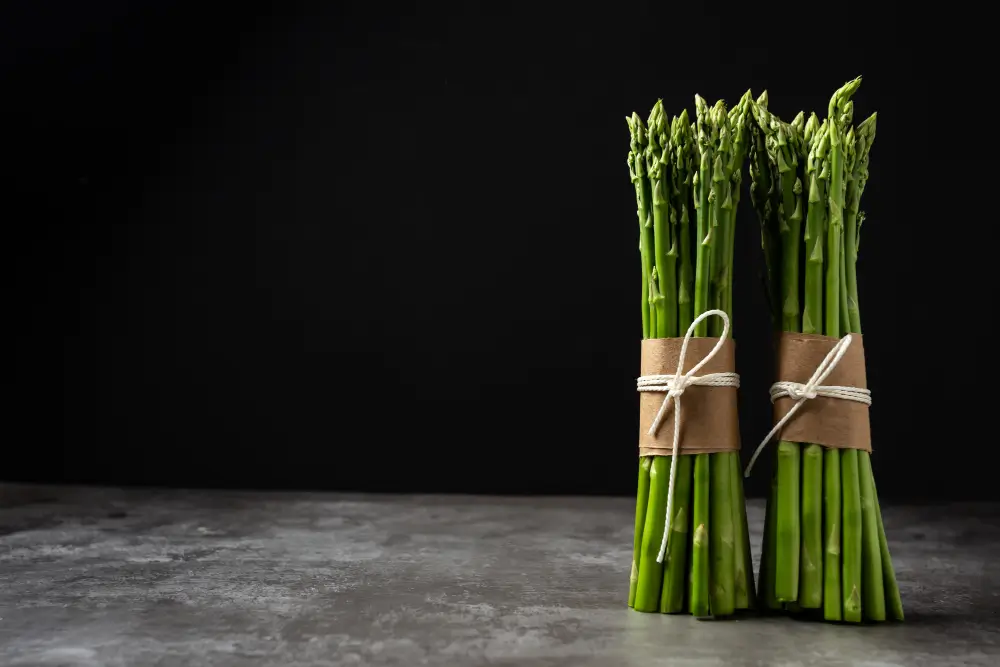
Growing Asparagus at home: A beginner’s guide to planting asparagus crowns
Asparagus, also known as Garden Asparagus and Sparrow grasses, is an ancient vegetable plant belonging to the Asparagaceae family and is scientifically named Asparagus officinalis. This plant has developed in the east Mediterranean and Asia Minor. Known for its tender, juicy spears, this is one plant you won’t have to acquire a taste for. Beyond its high-end cachet, asparagus is extremely versatile in cooking.
The Egyptians were the first to cultivate Asparagus in about 3000 BCE. Romans, too, would later adore the veggie and develop sophisticated methods of cultivation and freezing. They would use the Alps to freeze Asparagus spears for use in winter. Interestingly, because of its popularity, Asparagus earned the name "Food of Kings" during the Renaissance period. Subsequent to the 18th century, Asparagus was cultivated well enough to be accessible for the masses.
Asparagus vegetable benefits both commercial and home gardeners. People usually buy stored Asparagus, but it often loses its quality during storage and transport. So, planting Asparagus at home provides tastier and fresher spears. Planting Asparagus is not only rewarding but also fun and good. It makes the home garden look great and brings peace of mind.
Growcycle provides the best tips to grow Asparagus at home or on a commercial scale. It provides a wide variety of farming inputs and services and also provides farmers with the latest in farming technologies. Growcycle can offer tailor-made solutions depending on your level of cultivation – they can provide expert solutions to commercial as well as home planters to help their sowings be successful.
Botanical Description
The leaves of the asparagus have the form of very small scales. The plant has unusual stems, known as cladodes, which function like leaves to make food via photosynthesis. The cladodes are aggregate and needle-shaped of about 1 mm of width. The stems look feathery due to those cladodes. Stems are up to approximately 150 cm high and are rather strong.
Groups of roots of Asparagus plants are called crowns. The crowns create young, tender shoots, called spears. The root system is a deep and wide spread mass of fibrous roots which give strength to the plant and anchor it into the soil, as well as being the part responsible for the nutrient uptake and water.
Asparagus usually looks green. White Asparagus mounds the earth over the emerging spears to keep them from turning green. So, they are white due to the lack of chlorophyll. Ornamentally we have the green, feathery leaves, also referred to as Ferns as well. The flowers of asparagus are extremely pretty, small in size, bell-shaped, and yellowish or greenish-white. It's safe for people to eat the young Asparagus stems, but the little red coloured berries on the plant can be extremely harmful to humans.
Nutritional BenefitsAsparagus is nutrient-dense and low in calories - a delicious thing to eat. A 90 g cooked asparagus contains:
- Calories: 20
- Protein: 2.2 grams
- Fat: 0.2 grams
- Fiber: 1.8 grams
- Vitamin C: 12% of the RDI
- Vitamin A: 18% of the RDI
- Vitamin K: 57% of the RDI
- Folate: 34% of the RDI
- Potassium: 6% of the RDI
- Phosphorous: 5% of the RDI
- Vitamin E: 7% of the RDI
It is high in antioxidants and protects the body's cells from oxidative stress. It helps the body destroy free radicals to avoid cancer-like chronic diseases. High insoluble fiber also promotes digestive health by promoting regular bowel movements, which can help reduce the occurrence of chronic constipation. So other than promoting good bacteria in the gut, it unblocks the metabolism too.
Asparagus is high in folate or Vitamin B9, it is good for female for pregnancy. It helps to prevent neural tube defects, and it helps DNA form in the growing baby. Asparagus also supports blood pressure, particularly if it shoots up anywhere. It can secrete salt from the body to avoid hypertension. It is an antiviral, anti-inflammatory, and most significantly anti-cancer agent. Its active vitamin K content also promotes the repair and production of bone. It further helps maintain healthy blood clotting to minimize blood loss.
Asparagus is most likely just safe and healthy to consume. However, since there may be some allergic reactions to it, you should take it with advice and in a moderate way from a personal physician. What’s more, Asparagus acid may interact with certain medications and kidney conditions, causing serious health problems.
Different Varieties of Asparagus
There are several varieties of Asparagus plant because of the differences in terms of color, taste, hardiness and texture. Green, white, purple and wild Asparagus forms are found widely. Veggie gardeners grow these types because some can be eaten, and others are ornamental. And here are some common forms of this adaptable plant.
1. Green Asparagus
The green variety is readily available at grocery stores and farmers markets worldwide. This veggie is doubly famous because it contains some rich nutrition facts, including folic acid, potassium, and vitamins. Its bright green color and flavor are intensified after cooking, but its high fiber content means it can be tough to digest for some people.
2. Purple Asparagus
Purple Asparagus gets its coloration from the pigment anthocyanin, which is a healthy antioxidant. Purple Asparagus also contains more natural sugar than the green varieties, for a little sweetness in every bite! It is less fibery and therefore easier to chew, but the outer skin is also a bit tougher. Cooking generally reduces the firmness, preserving the appetizing color and flavor.
3. White Asparagus
White Asparagus is one of the most popular items in European meals for it's mild and delicate flavor. The harvesting process is different and challenging for formers. It is sown beneath the ground and buried under a thick layer of earth or black plastic so that no photosynthesis can take place. It’s white in color because it interacts less with the sun.
4. Wild Asparagus
Its name wild is to show that it is widespread in the wild and in all the countries. The plant prefers the moist soil, wild asparagus can be found on coastal cliffs and dunes. It looks unlike its cultivated cousins, which have shorter, fatter crops.
5. Trinorma Asparagus
This variety is a cross between purple, white, and green Asparagus. Its three-color spectrum has something of a visual punch. A dessert using Trinoma adds a threesome of flavors. Green and purple on the tart side, white on the sweet — can all be enjoyed together. Nutritionally, it’s also a three-in-one package. All the antioxidants, minerals and vitamins can be ingested in one dish.
6. Atlas Asparagus
Atlas is versatile enough to tolerate all weather conditions of frost, drought and shiny exposure. It also holds up well. The primary color of this variety is green, with the tips having a bit of purple as well. Its high yielding capacity is excellent for the home garden. Atlas spears are thick but soft and edible.
7. African Asparagus Fern
Its lovely lacy fern-like leaves make it very suitable to add to the garden for decoration. This fern is also called the bridal creeper because the young growing tips develop into leaves. Its interior planting is extensive and the bright colours of the African Asparagus add a decorative touch to the gardens.
The Asparagus Growing Cycle
Asparagus does not grow instantly; it takes years from seedling to crop. As it grows slowly, its yield continues for decades. Spring and early summer are considered the best for seeds to sprout.
The dormancy period of Asparagus begins in winter and lasts until early spring. Once sown in a controlled atmosphere, germination is continual and takes 2 or 3 weeks. The plant goes into the pots or nursery bed stage in 1 year. Time is what matures the young spears.
The crop does need some looking after and protection from spear picking at this point. It takes 3-4 years for asparagus to grow from seeds to crop-producing spears.
A Beginner’s Guide to Planting Asparagus Crowns
Long-term productive asparagus takes patience to put in the ground. The process includes a number of steps to protect and maintain the health of the plantation. The following is a step-by-step guide on how to plant Asparagus:
1. Preparation for Planting
Asparagus requires special pH and sunlight for healthy growth. It flourishes well in a place where at least 6 - 7 hours of sunlight to work together. The soil of the planting area should be well-drained and have a pH of 6.5 - 7
It’s key consider the temperature when planting because temperature does change how “to care for” tips. It is best to plant this way in the spring. Pick crowns that are dark brown with strong roots for the best success. Roots 6-8 inches are perfect, don't use too much longer than that or those that are tangled, as the longer and more twisted roots are hard to work with.
2. Soil Preparation
Out of the above crucial points, which are properly evaluated and corrected, the planting procedure begins with the soil preparation. You can use a pH meter to test the soil you selected. And it ought not hold water after a rain and be within a well-drained soil. The available soil may be improved by addition of organic matter. The changes will address the pH and drainage issues.
Raised beds are a good choice if planting is to be more successful. Asparagus growth requires that the beds be 48 inches wide and 96 inches long. The Asparagus crowns must be planted in loose soil where the roots can develop healthily. The soil should be loose and 6 - 8 inches deep to prepare the planting trench.
3. Planting Asparagus Crowns
Crown placing is the easy act of covering crowns after the soil has been dug and requires some tenderness and special handling of the roots to avoid damage of the crowns. At the time of planting, crowns must be covered with 2 inches of soil. The trench will be slowly filled with the appearance and growth of young shoots. Spacing is required to allow the crown to develop its root system. A 6 - 12-inch separation is required between single crowns of a trench.
Water the planting crowns in thoroughly so they can down roots in the soil. Continue to routinely water them to help them grow, but be sure not to overwater, which will damage the roots. The soil should remain damp, but not sodden. You can speed them up by adding more fertilizer. In locations where the weather and soil are conducive, growers can apply mulch that is comprised of old manure or leaves to help maintain moisture and prevent the growth of weeds.
4. First-Year Care
In the first year of growth, the crown must be watered once a week. If it does not rain weekly the patches should be dipped in one inch of water. Sandy soil requires more repen tance than does stiff (heavy) clay. Growers should stagger the schedule based on soil type.
Health stability also requires management of weeds (weeds intervene in the growth cycle searching for water, light, and soil nutrients). Removing weeds from between the rows is also likely the simplest alternative for control. Fertilization is accompanied by a shorter delay before initiation of growth also the rate of growth. A balanced fertilizer can be used as a top dressing, or it can be mixed with a water source.
Beetles can damage Asparagus plants by laying eggs on the spears, where the plant is injured. Growers can remove them by handpicking or dropping them in soapy water. A quality fungicide spray will also assist in killing these pests.
5. Second-Year Care
This is the period of the development of spears and neglect here will result in pest infestation. Slow-release fertilizer can be applied in the growing season, but for the application method, please refer to the instructions on the packaging. The ridges should be kept moist, and the growing beds must be weeded in the second year. In the second year, it takes pressure off the ferns to harvest them, and keeps the spears growing until they are fully developed.
Monitoring for pests and disease attacks is also essential for fern growth. Gardeners should watch for any signs of disease or pests. Asparagus aphids are light green and visible, being 3/32 inch long. Good housekeeping and some simple spacing are the key to keeping Asparagus during the growing season. The ferns need staking because if left without support, heavy wind may break them.
6. Ongoing Care and Maintenance (Year 3 and Beyond)
When the ferns become ready for spears, it is the year to receive the rewards from Asparagus planting. Soil pH measurement in the farmers’ field would then to be studied to know the changes to be applied. Any extra garbage or superfluous trees can be eliminated for clear growth. The materials that may be incorporated are also beneficial as soil structure materials.
Ferns can be read like a face, allowing growers to assess the vitality of their plantation. And if they’re healthy and strong, it means the plantation is doing the right things. After they stop growing, cut the ferns to the ground. This is helpful in disease and pest incidents. Do this when the ferns begin to turn yellow or brown.
7. Harvesting Asparagus
Growers can begin harvesting their plants after three years of growth. The harvesting period stretches 2-3 weeks, but in the following years may expand to 4-6 weeks. Spears 6-8 inches long are ideal when they are harvested. Their tips should be very tightly closed, and they should be picked before they are allowed to open, when they become ferns.
A sharp knife or Asparagus cutter works best for the fine cutting, as crowns should be preserved for future growth. The spears of asparagus grow so fast when it’s time to cut them off that checking daily is a necessity if you want to have fresh spears to cut. After the season, older clumps of canes should be left for fern production. These ferns will reserve energy for the following photosynthesis reactions. These ferns required the same amount of repetition of care and fertilizers for growing.
Companion Planting and Crop Rotation
There are also other best companion plants for Asparagus like tomatoes since it releases solanine. Solanine can also be used to deter, and even paralyze, Asparagus beetles from garden crops. Parsley does the same to pesticides too and will enhance Asparagus flavor. Ladybirds and lacewings are even more beautiful pests for Asparagus, and growing dill is highly beneficial for luring them in. Additionally, nasturtiums also serve as the ideal trap crop for aphids.
Marigold flowers provide a strong barrier to protect Asparagus from nematodes. Keep weeds under control and preserve your garden soil's moisture content with the help of a thick layer of mulch. Likewise, horseradish is a natural weed suppressor, and spinach can beneficially use the space between Asparagus plants.
But potatoes and alliums - onions, garlic and leeks - and carrots are best kept apart from Asparagus. They vie for the same nutrients, crowd the space and stunt growth.
Identifying & Fixing Common Issues
Under the best circumstances, focusing on the issues which may damper Asparagus growth are also key. Being aware of these factors can help growers avoid problems to the plant and enhance crop production. Some common concerns:
- Thin or Weak Spears
The spears are highest in quality when plants have been grown for at least three years. So, spears of plants less than three years old or more than ten years old are, for the most part, thin and unsatisfactory. Waiting until plants are three years old to cut them for new plants, replacing older crowns, or splitting them are the most efficient methods to deal with the problem.
Spears are also thin due to a lack of nutrients. Asparagus is a greedy feeder with a number of nutrient needs, so it's important to feed it with a balanced fertilizer to ensure that your spears are big, healthy, and fresh.
- Irregular Growth Patterns
This problem is more pronounced on most asparagus plants. Early ferning is the common cause and is due to high temperatures and uneven watering.
Regular water is the key to preventing this. Further, it is due to the movement of the crowns, as well. As crowns ascend over time, it results in a change in growth. Some pests, such as beetles, can set back growth or make it uneven, so managing those – organically and chemically – can reverse the matter.
- Yellowing Ferns
Asparagus can suffer from yellowed ferns. This frequently occurs due to overwatering, too little light, lack of nutrition, pests, or diseases. To remedy this, take care to allow your soil to drain so that your plants don’t get stem rot. It needs the minimum sunlight, for example, 6 hours a day, but in case there is not enough, artificial grow lights should be used to substitute natural sunlight.
- Poor yields
It can be annoying when poor yields happen. The main reasons are low pH, poor soil preparation, old plant crowns, and, most commonly, not enough fertilizer.
To remedy it, faithfully apply nitrogen-rich fertilizers, work in plenty of organic matter to loosen the soil, add lime to adjust the pH, and replace the crowns every 10 years.
FAQs
How to fertilize Asparagus for maximum growth?
The important steps for successful fertilization are having well-drained soil preparation with well-decayed manure, early spring feeding after fruit set, post-harvest feeding, yearly maintenance, and not overfeeding.
What are the signs that Asparagus is ready to be harvested?
The key signs to look at when you want to harvest them are the height, the width, and the condition of the tip. The ideal height is a maximum of 10 inches, while a half-inch thickness ensures that Asparagus is ready to harvest. Harvesting in the early morning and late evening is the best. It is as effective to cut spears with a sharp knife, rather than to snap them off.
How do I protect Asparagus plants during the winter?
It’s important to cut the foliage back to about an inch to avoid disease and prepare the plant for dormancy. Similarly, by mulching you help keep the moisture needed while you stop watering, also preventing root rot.
The Bottom Line
Growing Asparagus is a great way to have fresh produce without much maintenance, but be patient! It may require a few years to develop fully, but the wines can easily keep for 10 to 15 years. Most importantly, select the right type for your local climate and soil type. Even planting depth and good drainage promote good root development.
Growcycle is dedicated to supporting plant lovers and growers worldwide. They provide essential farming tools and also provide insurance and financing services. The firm is reputed as reliable, expert, and trustworthy. Consulting with Growcycle can accelerate your Asparagus growth rate.
Disclaimer: This material is for informational purposes only and should not be relied on for legal, medical, financial, or other professional advice.







